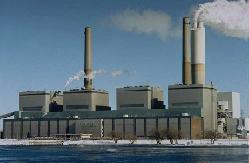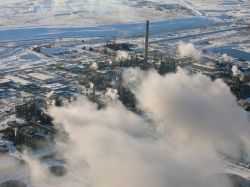If you think 567 pages of emissions data would make a boring read, this week's news just proved you wrong.
Canada's most recent report to the UN's climate change convention has proven surprisingly controversial, not so much for what's in it as for what was left out. Media reports from across Canada, the U.S. (subscription required) and the U.K. this week took Canada to task for failing to provide an estimate of greenhouse gas emissions from the oilsands in the federal government's annual report.
The media stories have provoked some interesting questions about transparency, accountability and what's really going on in the oilsands. This blog gives a bit of background about what the annual emission reports do, and why we can all benefit from a greater understanding of where Canada's greenhouse gas pollution comes from.
What's in an inventory
Under the UN Framework Convention on Climate Change, developed countries like Canada have to publish an annual technical account of their greenhouse gas emissions called a National Inventory Report. International experts review these reports each year to make sure that the governments who prepare them use appropriate methodologies, and there are international guidelines specifying what needs to be included.
The data always comes out after a 16-month lag, so this year's edition provides information about Canada's 2009 emissions.
 A quick glance at the report's summary shows some good news: Canada's total emissions fell by 6 per cent between 2008 and 2009, a drop that the report attributes mainly to the effect of the recession and to reduced use of coal to generate electricity.
A quick glance at the report's summary shows some good news: Canada's total emissions fell by 6 per cent between 2008 and 2009, a drop that the report attributes mainly to the effect of the recession and to reduced use of coal to generate electricity.
A reduction in Canada's greenhouse gas pollution is certainly something to celebrate, although the effects of phasing out coal in Ontario are likely to be much more permanent than the temporary blip of the recession.
In fact, despite this year's data, Environment Canada's own analysis shows that emissions are projected to keep growing — even once all the policies governments have announced in Canada go into effect — to 785 million tonnes by 2020, or about 12 per cent above the 690 million tonnes Canada produced in 2009.
Internationally, Canada's 6 per cent drop from 2008 to 2009 lines up with some of its peer countries: U.S. emissions also fell by 6 per cent, and the EU's fell by 7 per cent, over the same period.
Inside Canada, provincial emissions results almost always generate some interest. Although Ontario is no longer Canada's top emitter — a title it has lost in recent years to Alberta — the province is still probably the standout emissions story for 2009. Ontario's emissions fell by 13 per cent from 2008 to 2009, moving the province to 7 per cent below its 1990 emission level — a result that (for now at least) puts Ontario ahead of its 2014 target , which is to reduce emissions to 6 per cent below the 1990 level.
What's not in Canada's inventory
As Postmedia journalist Mike de Souza reported this week, this year's report failed to answer a simple question that many Canadians might be curious about: just how much greenhouse gas pollution did the oilsands generate?
The report does account for emissions from Canada's fastest-growing source of greenhouse gas pollution, but it does so under broader categories like "Mining and Oil and Gas Extraction" or "Fugitive Emissions." Reading through the document, there's no way to find out what's happening with oilsands emissions specifically.
Given how much attention that sector generates in Canada and abroad, it's an omission that jumped out at us too. Good information about greenhouse gas pollution in the oilsands is especially critical this year, because Environment Minister Peter Kent now says he's going to set emission regulations that include the oilsands.
 Officials at Environment Canada were able to provide an estimate of oilsands emissions to Postmedia, and it's an interesting one. As of 2009, the sector is responsible for about 6.5 per cent of Canada's national emissions, a jump of over 20 per cent from last year's published level (from 37.2 million tonnes to about 45 million tonnes). That growth occurred despite the recession Canada faced in 2009.
Officials at Environment Canada were able to provide an estimate of oilsands emissions to Postmedia, and it's an interesting one. As of 2009, the sector is responsible for about 6.5 per cent of Canada's national emissions, a jump of over 20 per cent from last year's published level (from 37.2 million tonnes to about 45 million tonnes). That growth occurred despite the recession Canada faced in 2009.
Environment Canada's clarifications
Environment Canada officials have provided new context, both to reporters and to environmentalists, since the original media stories came out earlier this week. In the interests of fairness, I think it's important to give their side of the story too.
In an email to journalist Mike de Souza, Environment Canada explained that its estimate of 6.5 per cent of total national emissions coming from the oilsands is preliminary, and needs to be finalized once the department has more information about electricity use in the oilsands. Based on improvements in methodologies, though, it estimates that the oilsands made up 5.5 per cent of Canada's 2008 emissions, not 5 per cent as previously reported. If that conclusion holds up, it would make the increase in oilsands emissions from 2008 to 2009 smaller than the 21 per cent it looks like right now, at about 11 per cent growth from 2008 to 2009.
Canada's sectors vs. the world's
In response to questions about why you can't find out the oilsands' emissions in this year's inventory, Environment Canada explained that it followed the international guidelines that set emissions categories. Those guidelines don't require countries to report oilsands emissions as a separate category.
But Environment Canada did go beyond the UN's template to publish an estimate of oilsands emissions last year. That information is found in two tables in the 2008 National Inventory Report (2-16 and 2-18) that are a gold mine for people who want to understand where emissions come from. Those tables present our country's emissions in terms that are more familiar to Canadians, using categories like oilsands (mining, in situ, upgrading), cars, buses, cement, forestry, and even service industries.
When we think about Canada's economy, it's those kinds of sectors that most of us consider. Sectoral data allows for comparisons between the parts of the economy we're familiar with, like petroleum refining or pulp and paper production. That information was a step in the right direction towards transparency about emissions in Canada, and possibly even towards greater "literacy" about energy and greenhouse gases. Sectoral data is also the most relevant for setting policies.
Here at Pembina, we used those tables to put together a one-page summary that shows total emissions and rates of growth in the key sectors. I use it at least twice a week in my work, and I bet I'm not alone.
This year, Environment Canada decided to end what it called the "pilot" project of showing sector-by-sector emissions, explaining that it has found "weaknesses in the methodology and gaps in the data" that need fixing.
So while the omission of the oilsands has received most of the attention, they're not alone. This year's report also leaves out emission estimates for sectors across Canada's economy.
We've published a preliminary one-pager for 2009, but without that sectoral data, we had to make estimates in several places. We hope to sharpen it up if the government does publish sector-by-sector emission estimates; fortunately, it has committed to do exactly this. Writing to Mike de Souza, officials at Environment Canada said that they plan to "report economic sector emissions separately once the statistics and methodology are finalized."
We'll work to hold them to that. Reporting on oilsands emissions, along with those from other sectors, was a successful pilot project that needs to be continued. As this week's news stories have shown, failing to be transparent about sector-by-sector emissions just raises new questions — about why the information isn't available and, from some quarters, about whether there's something to hide.
More and more Canadians know that the oilsands are our fastest-growing source of greenhouse gas pollution. Canadians deserve to understand how quickly that growth is really happening, and whether the sector has at least managed to improve its ratio of emissions per barrel produced (emissions intensity), even when its absolute emissions are increasing.
Of course, transparency is only the first step. Once we know the size of the problem, governments — along with Canadians and companies — need to adopt solutions that cut our greenhouse gas pollution.
But let's not get hung up on step one. There are important discussions to be had about how we manage the environmental impacts of oilsands development. Environment Canada can, and should, provide the information that Canadians need to have those conversations.
Clare Demerse was the director of federal policy at the Pembina Institute until 2014.



